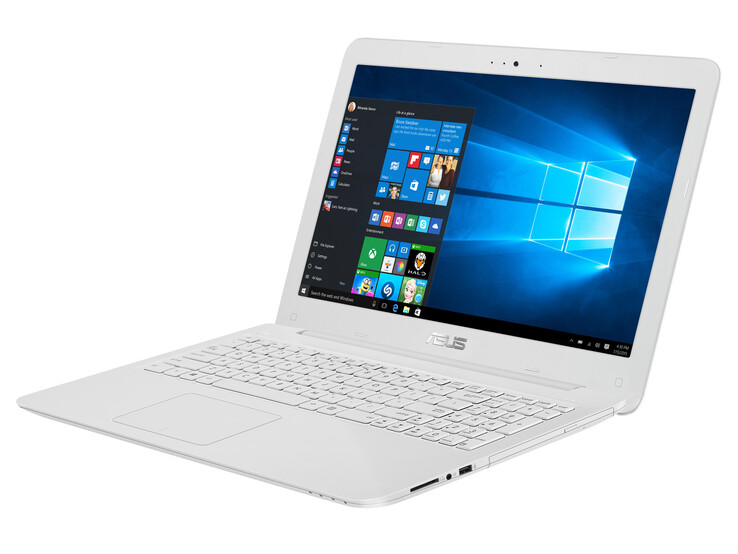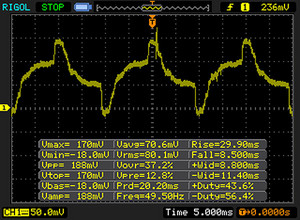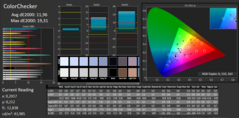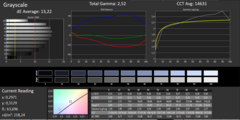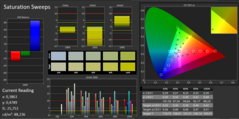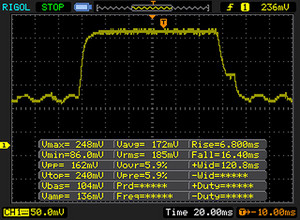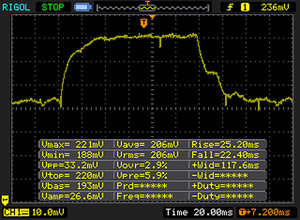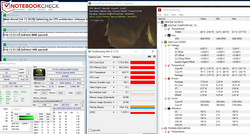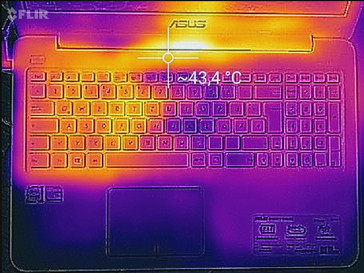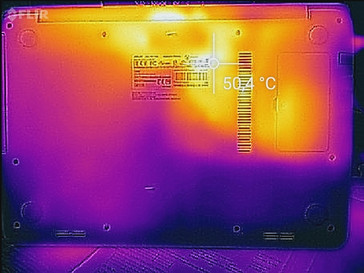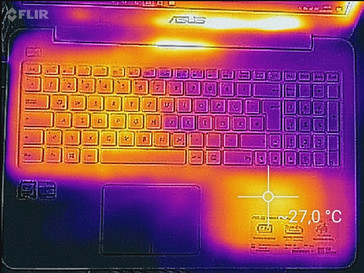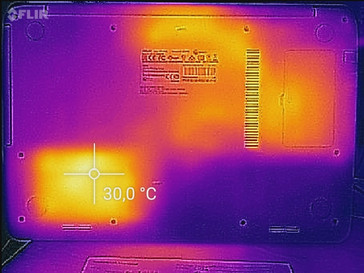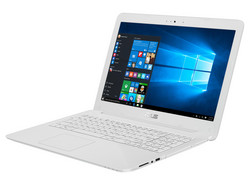Asus Vivobook F556UQ-XO626D Notebook Review

For the original German review, see here.
The Asus Vivobook F556UQ-XO626D is the identically designed sibling of the Vivobook X556UQ-XO076T, which we already reviewed in summer 2016. The current test model differs from its sibling in two aspects: With the Core i5-6198DU, it features a Skylake processor, which is not too often found in notebooks. The second difference is the look: Asus uses a snow-white chassis with white keys. The competitors include devices such as the HP 15-ba077ng, the Acer Aspire E15 E5-553G, and the Lenovo IdeaPad 310-15ISK.
Since the F556UQ and the X556UQ share the same design, we will not cover case, connectivity, input devices, display, and speakers in detail here. Information about these is available in our X556UQ review.
| SD Card Reader | |
| average JPG Copy Test (av. of 3 runs) | |
| Acer Aspire E15 E5-553G-109A | |
| HP 15-ba077ng | |
| Asus Vivobook F556UQ-XO626D | |
| Asus VivoBook X556UQ-XO076T | |
| Medion Akoya P6670 | |
| Lenovo Ideapad 310-15ISK | |
| maximum AS SSD Seq Read Test (1GB) | |
| Acer Aspire E15 E5-553G-109A | |
| HP 15-ba077ng | |
| Asus VivoBook X556UQ-XO076T | |
| Medion Akoya P6670 | |
| Lenovo Ideapad 310-15ISK | |
| Asus Vivobook F556UQ-XO626D | |
| Networking | |
| iperf3 transmit AX12 | |
| Acer Aspire E15 E5-553G-109A | |
| Asus Vivobook F556UQ-XO626D | |
| HP 15-ba077ng | |
| iperf3 receive AX12 | |
| Asus Vivobook F556UQ-XO626D | |
| Acer Aspire E15 E5-553G-109A | |
| HP 15-ba077ng | |
Display
The Vivobook features a matte 15.6-inch display with a native resolution of 1366x768 pixels. It is the same dark, low-contrast, viewing-angle unstable model which we are familiar with from the already reviewed sibling. Nevertheless, the measurement results are slightly different, since two identical panels are never exactly the same.
We could not detect PWM for reducing the brightness, but a permanent flickering caused by the power adapter (in mains operation, not on battery). See the screenshot besides PWM. However, this flickering is only measurable; it is neither notable nor disturbing.
| |||||||||||||||||||||||||
Brightness Distribution: 81 %
Center on Battery: 217 cd/m²
Contrast: 365:1 (Black: 0.6 cd/m²)
ΔE ColorChecker Calman: 11.96 | ∀{0.5-29.43 Ø4.77}
ΔE Greyscale Calman: 13.22 | ∀{0.09-98 Ø5}
62% sRGB (Argyll 1.6.3 3D)
39% AdobeRGB 1998 (Argyll 1.6.3 3D)
42.04% AdobeRGB 1998 (Argyll 3D)
61.3% sRGB (Argyll 3D)
40.69% Display P3 (Argyll 3D)
Gamma: 2.52
CCT: 14631 K
| Asus Vivobook F556UQ-XO626D TN LED, 1366x768, 15.6" | Asus VivoBook X556UQ-XO076T TN LED, 1366x768, 15.6" | HP 15-ba077ng TN LED, 1920x1080, 15.6" | Acer Aspire E15 E5-553G-109A TN LED, 1920x1080, 15.6" | Lenovo Ideapad 310-15ISK TN LED, 1366x768, 15.6" | Medion Akoya P6670 IPS, 1920x1080, 15.6" | |
|---|---|---|---|---|---|---|
| Display | 1% | -2% | -2% | -9% | -6% | |
| Display P3 Coverage (%) | 40.69 | 41.1 1% | 39.98 -2% | 39.72 -2% | 37.06 -9% | 38.14 -6% |
| sRGB Coverage (%) | 61.3 | 61.8 1% | 60.2 -2% | 59.2 -3% | 55.8 -9% | 57.2 -7% |
| AdobeRGB 1998 Coverage (%) | 42.04 | 42.46 1% | 41.31 -2% | 41.07 -2% | 38.29 -9% | 39.43 -6% |
| Response Times | 3% | 8% | 24% | 24% | 8% | |
| Response Time Grey 50% / Grey 80% * (ms) | 47 ? | 36 ? 23% | 42 ? 11% | 42.4 ? 10% | 27 ? 43% | 42 ? 11% |
| Response Time Black / White * (ms) | 23 ? | 27 ? -17% | 22 ? 4% | 14.6 ? 37% | 22 ? 4% | 22 ? 4% |
| PWM Frequency (Hz) | 50 ? | 28740 | 50 ? | 50 | ||
| Screen | 27% | -1% | 7% | 16% | 21% | |
| Brightness middle (cd/m²) | 219 | 241 10% | 209 -5% | 224 2% | 200 -9% | 287 31% |
| Brightness (cd/m²) | 220 | 240 9% | 200 -9% | 201 -9% | 198 -10% | 269 22% |
| Brightness Distribution (%) | 81 | 92 14% | 88 9% | 75 -7% | 83 2% | 74 -9% |
| Black Level * (cd/m²) | 0.6 | 0.5 17% | 0.56 7% | 0.46 23% | 0.28 53% | 0.65 -8% |
| Contrast (:1) | 365 | 482 32% | 373 2% | 487 33% | 714 96% | 442 21% |
| Colorchecker dE 2000 * | 11.96 | 4.46 63% | 12.21 -2% | 10.5 12% | 10.63 11% | 5.42 55% |
| Colorchecker dE 2000 max. * | 19.31 | 6.84 65% | 20.66 -7% | 16.8 13% | 15.69 19% | 9.54 51% |
| Greyscale dE 2000 * | 13.22 | 4.83 63% | 13.48 -2% | 11.23 15% | 11.19 15% | 5.14 61% |
| Gamma | 2.52 87% | 2.49 88% | 2.34 94% | 2.12 104% | 1.78 124% | 2.48 89% |
| CCT | 14631 44% | 7773 84% | 15364 42% | 11096 59% | 11258 58% | 6952 93% |
| Color Space (Percent of AdobeRGB 1998) (%) | 39 | 39 0% | 38 -3% | 38 -3% | 35 -10% | 36 -8% |
| Color Space (Percent of sRGB) (%) | 62 | 62 0% | 60 -3% | 59 -5% | 56 -10% | 57 -8% |
| Total Average (Program / Settings) | 10% /
19% | 2% /
-0% | 10% /
8% | 10% /
12% | 8% /
14% |
* ... smaller is better
Screen Flickering / PWM (Pulse-Width Modulation)
| Screen flickering / PWM not detected | |||
In comparison: 53 % of all tested devices do not use PWM to dim the display. If PWM was detected, an average of 8083 (minimum: 5 - maximum: 343500) Hz was measured. | |||
Display Response Times
| ↔ Response Time Black to White | ||
|---|---|---|
| 23 ms ... rise ↗ and fall ↘ combined | ↗ 7 ms rise | |
| ↘ 16 ms fall | ||
| The screen shows good response rates in our tests, but may be too slow for competitive gamers. In comparison, all tested devices range from 0.1 (minimum) to 240 (maximum) ms. » 51 % of all devices are better. This means that the measured response time is worse than the average of all tested devices (20.2 ms). | ||
| ↔ Response Time 50% Grey to 80% Grey | ||
| 47 ms ... rise ↗ and fall ↘ combined | ↗ 25 ms rise | |
| ↘ 22 ms fall | ||
| The screen shows slow response rates in our tests and will be unsatisfactory for gamers. In comparison, all tested devices range from 0.165 (minimum) to 636 (maximum) ms. » 80 % of all devices are better. This means that the measured response time is worse than the average of all tested devices (31.6 ms). | ||
Performance
With the Vivobook F556UQ, Asus has a 15.6-inch all-round device in its line-up. It brings sufficient performance for everyday tasks and is able to run games. Our test model costs about 460 Euros (~$485) and is currently the cheapest variant of this series. Other configurations and color variants are available. Models of the identically designed X556UQ series increase the choice of products.
Processor
The Vivobook is powered by a Core i5-6198DU (Skylake) dual-core processor. This is basically a Core i5-6200U processor with a weaker iGPU (HD Graphics 510 instead of HD Graphics 520) than usual. The used CPU is a mid-range ULV model, which should suffice for most users' requirements. The Core i5 processor works at a base clock of 2.3 GHz. Thanks to Turbo, the clock rate can increase to 2.7 GHz (both cores) and 2.8 GHz (single core). The Turbo is actually used in mains operation and on battery.
| Geekbench 3 | |
| 32 Bit Single-Core Score | |
| Asus VivoBook X556UQ-XO076T | |
| Asus Vivobook F556UQ-XO626D | |
| Medion Akoya P6670 | |
| Acer Aspire E15 E5-553G-109A | |
| HP 15-ba077ng | |
| 32 Bit Multi-Core Score | |
| Asus Vivobook F556UQ-XO626D | |
| Asus VivoBook X556UQ-XO076T | |
| Medion Akoya P6670 | |
| Acer Aspire E15 E5-553G-109A | |
| HP 15-ba077ng | |
| Geekbench 4.0 | |
| 64 Bit Single-Core Score | |
| Asus Vivobook F556UQ-XO626D | |
| Medion Akoya P6670 | |
| HP 15-ba077ng | |
| 64 Bit Multi-Core Score | |
| Asus Vivobook F556UQ-XO626D | |
| Medion Akoya P6670 | |
| HP 15-ba077ng | |
| JetStream 1.1 - Total Score | |
| Lenovo Ideapad 310-15ISK | |
| Asus Vivobook F556UQ-XO626D | |
| Asus VivoBook X556UQ-XO076T | |
| Medion Akoya P6670 | |
| HP 15-ba077ng | |
System Performance
We did not face problems. The system works smoothly. The good results in the PCMark benchmarks confirm our subjective impression. The all-round device delivers sufficient performance for office and Internet applications. The computer can even run games. It is possible to further improve the system performance by replacing the HDD with an SSD. This would make the system more responsive and loading/opening of programs/files would take less time.
| PCMark 7 Score | 2864 points | |
| PCMark 8 Home Score Accelerated v2 | 3178 points | |
| PCMark 8 Creative Score Accelerated v2 | 3343 points | |
| PCMark 8 Work Score Accelerated v2 | 4231 points | |
Help | ||
| PCMark 8 - Home Score Accelerated v2 | |
| Lenovo Ideapad 310-15ISK | |
| Asus VivoBook X556UQ-XO076T | |
| Medion Akoya P6670 | |
| Asus Vivobook F556UQ-XO626D | |
| Acer Aspire E15 E5-553G-109A | |
| HP 15-ba077ng | |
Storage Device
A 2.5-inch hard drive from Toshiba is used as system drive. It works at 5400 RPM and features a storage capacity of 500 GB. The transfer rates of the HDD are normal for 5400-RPM models.
| Asus Vivobook F556UQ-XO626D Toshiba MQ01ABF050 | Asus VivoBook X556UQ-XO076T SK hynix SSD Canvas SC300 HFS256G32MND | HP 15-ba077ng SanDisk Z400s SD8SNAT-256G | Acer Aspire E15 E5-553G-109A Liteonit CV3-8D128 | Lenovo Ideapad 310-15ISK WDC Scorpio Blue WD10JPCX-24UE4T0 | Medion Akoya P6670 Phison S11-128G | |
|---|---|---|---|---|---|---|
| CrystalDiskMark 3.0 | 9189% | 5186% | 5407% | 38% | 6163% | |
| Read Seq (MB/s) | 102.2 | 434.9 326% | 447.4 338% | 348.6 241% | 115.9 13% | 441.8 332% |
| Write Seq (MB/s) | 90.7 | 318.3 251% | 243.3 168% | 311.8 244% | 113.3 25% | 398 339% |
| Read 512 (MB/s) | 23.31 | 311.8 1238% | 333.4 1330% | 295.9 1169% | 39.02 67% | 295.5 1168% |
| Write 512 (MB/s) | 21.7 | 319.2 1371% | 283.1 1205% | 185.8 756% | 55.6 156% | 75.5 248% |
| Read 4k (MB/s) | 0.486 | 18.23 3651% | 20.99 4219% | 23.76 4789% | 0.44 -9% | 31.19 6318% |
| Write 4k (MB/s) | 1.06 | 85.4 7957% | 62.7 5815% | 44.94 4140% | 1.188 12% | 60 5560% |
| Read 4k QD32 (MB/s) | 0.952 | 323.8 33913% | 143.1 14932% | 171.6 17925% | 1.125 18% | 258 27001% |
| Write 4k QD32 (MB/s) | 1.016 | 253 24802% | 138 13483% | 143.2 13994% | 1.245 23% | 85.7 8335% |
Graphics Card
The Vivobook comes with a dedicated GeForce 940MX graphics card from Nvidia. This model is a mid-range GPU. It supports DirectX 12 and clocks at up to 1176 MHz. The GPU is supported by 2048 MB DDR3 VRAM. The results of the 3DMark benchmarks are normal. Apart from the used GeForce 940MX variant, there are two other models. The latter feature GDDR5 VRAM. Further information about this is available in our Acer TravelMate P259-MG review.
| 3DMark 11 Performance | 2551 points | |
Help | ||
| 3DMark 11 - 1280x720 Performance GPU | |
| Acer Aspire E15 E5-553G-109A | |
| Medion Akoya P6670 | |
| Asus Vivobook F556UQ-XO626D | |
| Asus VivoBook X556UQ-XO076T | |
| HP 15-ba077ng | |
| Lenovo Ideapad 310-15ISK | |
Gaming Performance
The CPU-GPU combination of the Vivobook can run many games smoothly in HD resolution (1366x768 pixels) with low to medium quality settings. Higher settings are possible in games without high hardware requirements. An example is FIFA 17. However, many demanding games require decreasing the resolution and/or quality settings in order to achieve playable frame rates. Very demanding games such as Deus Ex Mankind Divided and Mafia 3 are unplayable.
| low | med. | high | ultra | |
|---|---|---|---|---|
| BioShock Infinite (2013) | 86.3 | 49.1 | 39.5 |
| BioShock Infinite - 1366x768 Medium Preset | |
| Medion Akoya P6670 | |
| Asus Vivobook F556UQ-XO626D | |
| Asus VivoBook X556UQ-XO076T | |
| Lenovo Ideapad 310-15ISK | |
| HP 15-ba077ng | |
Emissions and Energy
System Noise
In idle mode, the fan permanently runs at low speed, but it is not audible since the hard drive is louder. Even if the hard drive stands still, the fan can just be heard in very quiet environments if at all. The system will run significantly quieter in everyday use if you replace the HDD with an SSD. The fan certainly gets louder under load. We measured a noise level of 42.6 dB during the stress test.
An electronic noise can occasionally be heard. We observed this noise during copying gaming benchmarks to the hard drive. However, the noise is only audible in very quiet environments.
Noise level
| Idle |
| 32 / 32 / 32.2 dB(A) |
| HDD |
| 32.6 dB(A) |
| DVD |
| 37.6 / dB(A) |
| Load |
| 37.3 / 42.6 dB(A) |
 | ||
30 dB silent 40 dB(A) audible 50 dB(A) loud |
||
min: | ||
Temperature
Our Vivobook behaves slightly different in our stress test (Prime95 and Furmark run for at least one hour) in mains operation and on battery. The graphics core always clocks at full speed (1,176 MHz). In mains operation, the processor works at 2.2 to 2.3 GHz. The clock rate occasionally falls to 400 MHz. On battery, the CPU permanently clocks at 400 MHz. The notebook hardly gets warmer during the stress test (in mains operation). The temperatures remain below 40 °C in all measurement segments.
(+) The maximum temperature on the upper side is 35.5 °C / 96 F, compared to the average of 36.9 °C / 98 F, ranging from 21.1 to 71 °C for the class Multimedia.
(+) The bottom heats up to a maximum of 39.9 °C / 104 F, compared to the average of 39.2 °C / 103 F
(+) In idle usage, the average temperature for the upper side is 23.3 °C / 74 F, compared to the device average of 31.3 °C / 88 F.
(+) The palmrests and touchpad are cooler than skin temperature with a maximum of 27.5 °C / 81.5 F and are therefore cool to the touch.
(±) The average temperature of the palmrest area of similar devices was 28.7 °C / 83.7 F (+1.2 °C / 2.2 F).
Asus Vivobook F556UQ-XO626D audio analysis
(±) | speaker loudness is average but good (74 dB)
Bass 100 - 315 Hz
(-) | nearly no bass - on average 16.8% lower than median
(+) | bass is linear (5% delta to prev. frequency)
Mids 400 - 2000 Hz
(+) | balanced mids - only 3.1% away from median
(+) | mids are linear (5.6% delta to prev. frequency)
Highs 2 - 16 kHz
(±) | higher highs - on average 7.7% higher than median
(+) | highs are linear (6.6% delta to prev. frequency)
Overall 100 - 16.000 Hz
(±) | linearity of overall sound is average (20.4% difference to median)
Compared to same class
» 68% of all tested devices in this class were better, 8% similar, 24% worse
» The best had a delta of 5%, average was 17%, worst was 45%
Compared to all devices tested
» 53% of all tested devices were better, 8% similar, 39% worse
» The best had a delta of 4%, average was 24%, worst was 134%
Apple MacBook 12 (Early 2016) 1.1 GHz audio analysis
(+) | speakers can play relatively loud (83.6 dB)
Bass 100 - 315 Hz
(±) | reduced bass - on average 11.3% lower than median
(±) | linearity of bass is average (14.2% delta to prev. frequency)
Mids 400 - 2000 Hz
(+) | balanced mids - only 2.4% away from median
(+) | mids are linear (5.5% delta to prev. frequency)
Highs 2 - 16 kHz
(+) | balanced highs - only 2% away from median
(+) | highs are linear (4.5% delta to prev. frequency)
Overall 100 - 16.000 Hz
(+) | overall sound is linear (10.2% difference to median)
Compared to same class
» 7% of all tested devices in this class were better, 2% similar, 91% worse
» The best had a delta of 5%, average was 18%, worst was 53%
Compared to all devices tested
» 4% of all tested devices were better, 1% similar, 94% worse
» The best had a delta of 4%, average was 24%, worst was 134%
Frequency comparison (checkboxes select/deselectable!)
Power Consumption
There are no abnormalities in the realm of energy demand. The power consumption is normal for the used hardware platform regardless of the load. The 65-Watt power adapter does not reach its limits.
| Off / Standby | |
| Idle | |
| Load |
|
Key:
min: | |
Battery Life
Our real-world Wi-Fi test simulates the load during web surfing. The profile "Balanced" is active, the power-saving options are disabled and the display brightness is set to about 150 cd/m². The Vivobook achieves a battery life of 5:38 h, which surprisingly is 70 minutes shorter than its sibling's.
Pros
Cons
Verdict
The Asus Vivobook F556UQ is a 15.6-inch all-round laptop. It is not too expensive at a price of about 460 Euros (~$485). The used Core i5 processor is suitable for all usual fields of application. Together with the GeForce graphics card, it can run many current games smoothly. The computer hardly gets warmer regardless of the load and, at least during everyday use, it works quietly. Thanks to a 500 GB hard drive you will not run out of storage space quickly. It is possible to replace the hard drive with a higher-capacity model or an SSD. However, this requires opening the laptop. The existing maintenance hatch only allows access to the RAM slot.
With the Vivobook F556UQ, Asus delivers a balanced all-round device. You get high performance for a relatively low price.
The keyboard appeared to be decent and is sufficient for home use. Moreover, the battery runtimes are good. Usually, the display is a big weakness in budget notebooks. This is also true for the Vivobook. Asus incorporated a quite dark, low-contrast, viewing-angle unstable model. However, the display quality is acceptable in view of the price. Other manufacturers should follow this example.
Asus Vivobook F556UQ-XO626D
- 02/21/2017 v6 (old)
Sascha Mölck


